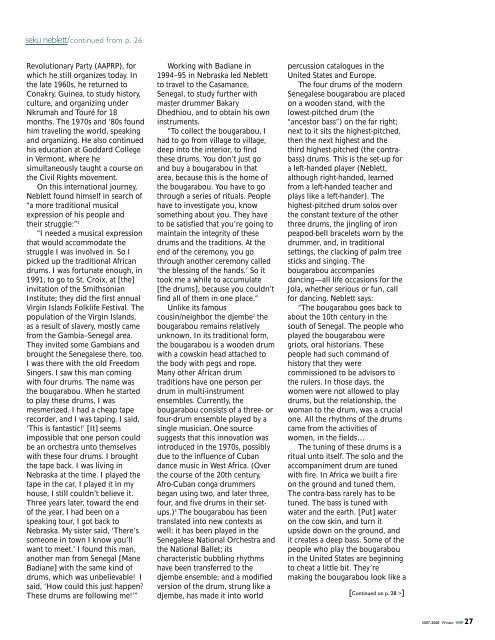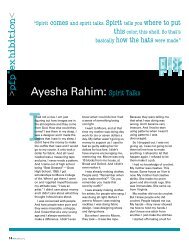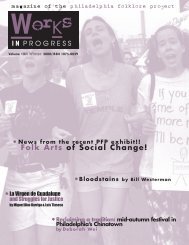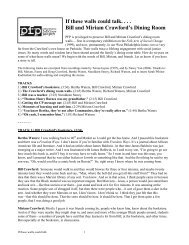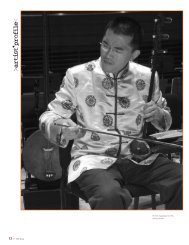African song / Fatu Gayflor ⢠War and wealth - Philadelphia Folklore ...
African song / Fatu Gayflor ⢠War and wealth - Philadelphia Folklore ...
African song / Fatu Gayflor ⢠War and wealth - Philadelphia Folklore ...
You also want an ePaper? Increase the reach of your titles
YUMPU automatically turns print PDFs into web optimized ePapers that Google loves.
seku neblett/continued from p. 26<br />
Revolutionary Party (AAPRP), for<br />
which he still organizes today. In<br />
the late 1960s, he returned to<br />
Conakry, Guinea, to study history,<br />
culture, <strong>and</strong> organizing under<br />
Nkrumah <strong>and</strong> Touré for 18<br />
months. The 1970s <strong>and</strong> ‘80s found<br />
him traveling the world, speaking<br />
<strong>and</strong> organizing. He also continued<br />
his education at Goddard College<br />
in Vermont, where he<br />
simultaneously taught a course on<br />
the Civil Rights movement.<br />
On this international journey,<br />
Neblett found himself in search of<br />
“a more traditional musical<br />
expression of his people <strong>and</strong><br />
their struggle:” 1<br />
“I needed a musical expression<br />
that would accommodate the<br />
struggle I was involved in. So I<br />
picked up the traditional <strong>African</strong><br />
drums. I was fortunate enough, in<br />
1991, to go to St. Croix, at [the]<br />
invitation of the Smithsonian<br />
Institute; they did the first annual<br />
Virgin Isl<strong>and</strong>s Folklife Festival. The<br />
population of the Virgin Isl<strong>and</strong>s,<br />
as a result of slavery, mostly came<br />
from the Gambia–Senegal area.<br />
They invited some Gambians <strong>and</strong><br />
brought the Senegalese there, too.<br />
I was there with the old Freedom<br />
Singers. I saw this man coming<br />
with four drums. The name was<br />
the bougarabou. When he started<br />
to play these drums, I was<br />
mesmerized. I had a cheap tape<br />
recorder, <strong>and</strong> I was taping. I said,<br />
‘This is fantastic!’ [It] seems<br />
impossible that one person could<br />
be an orchestra unto themselves<br />
with these four drums. I brought<br />
the tape back. I was living in<br />
Nebraska at the time. I played the<br />
tape in the car, I played it in my<br />
house, I still couldn’t believe it.<br />
Three years later, toward the end<br />
of the year, I had been on a<br />
speaking tour, I got back to<br />
Nebraska. My sister said, ‘There’s<br />
someone in town I know you’ll<br />
want to meet.’ I found this man,<br />
another man from Senegal [Mane<br />
Badiane] with the same kind of<br />
drums, which was unbelievable! I<br />
said, ‘How could this just happen?<br />
These drums are following me!’”<br />
Working with Badiane in<br />
1994–95 in Nebraska led Neblett<br />
to travel to the Casamance,<br />
Senegal, to study further with<br />
master drummer Bakary<br />
Dhedhiou, <strong>and</strong> to obtain his own<br />
instruments.<br />
“To collect the bougarabou, I<br />
had to go from village to village,<br />
deep into the interior, to find<br />
these drums. You don’t just go<br />
<strong>and</strong> buy a bougarabou in that<br />
area, because this is the home of<br />
the bougarabou. You have to go<br />
through a series of rituals. People<br />
have to investigate you, know<br />
something about you. They have<br />
to be satisfied that you’re going to<br />
maintain the integrity of these<br />
drums <strong>and</strong> the traditions. At the<br />
end of the ceremony, you go<br />
through another ceremony called<br />
‘the blessing of the h<strong>and</strong>s.’ So it<br />
took me a while to accumulate<br />
[the drums], because you couldn’t<br />
find all of them in one place.”<br />
Unlike its famous<br />
cousin/neighbor the djembe 2 the<br />
bougarabou remains relatively<br />
unknown. In its traditional form,<br />
the bougarabou is a wooden drum<br />
with a cowskin head attached to<br />
the body with pegs <strong>and</strong> rope.<br />
Many other <strong>African</strong> drum<br />
traditions have one person per<br />
drum in multi-instrument<br />
ensembles. Currently, the<br />
bougarabou consists of a three- or<br />
four-drum ensemble played by a<br />
single musician. One source<br />
suggests that this innovation was<br />
introduced in the 1970s, possibly<br />
due to the influence of Cuban<br />
dance music in West Africa. (Over<br />
the course of the 20th century,<br />
Afro-Cuban conga drummers<br />
began using two, <strong>and</strong> later three,<br />
four, <strong>and</strong> five drums in their setups.)<br />
3 The bougarabou has been<br />
translated into new contexts as<br />
well: it has been played in the<br />
Senegalese National Orchestra <strong>and</strong><br />
the National Ballet; its<br />
characteristic bubbling rhythms<br />
have been transferred to the<br />
djembe ensemble; <strong>and</strong> a modified<br />
version of the drum, strung like a<br />
djembe, has made it into world<br />
percussion catalogues in the<br />
United States <strong>and</strong> Europe.<br />
The four drums of the modern<br />
Senegalese bougarabou are placed<br />
on a wooden st<strong>and</strong>, with the<br />
lowest-pitched drum (the<br />
“ancestor bass”) on the far right;<br />
next to it sits the highest-pitched,<br />
then the next highest <strong>and</strong> the<br />
third highest-pitched (the contrabass)<br />
drums. This is the set-up for<br />
a left-h<strong>and</strong>ed player (Neblett,<br />
although right-h<strong>and</strong>ed, learned<br />
from a left-h<strong>and</strong>ed teacher <strong>and</strong><br />
plays like a left-h<strong>and</strong>er). The<br />
highest-pitched drum solos over<br />
the constant texture of the other<br />
three drums, the jingling of iron<br />
peapod-bell bracelets worn by the<br />
drummer, <strong>and</strong>, in traditional<br />
settings, the clacking of palm tree<br />
sticks <strong>and</strong> singing. The<br />
bougarabou accompanies<br />
dancing—all life occasions for the<br />
Jola, whether serious or fun, call<br />
for dancing. Neblett says:<br />
“The bougarabou goes back to<br />
about the 10th century in the<br />
south of Senegal. The people who<br />
played the bougarabou were<br />
griots, oral historians. These<br />
people had such comm<strong>and</strong> of<br />
history that they were<br />
commissioned to be advisors to<br />
the rulers. In those days, the<br />
women were not allowed to play<br />
drums, but the relationship, the<br />
woman to the drum, was a crucial<br />
one. All the rhythms of the drums<br />
came from the activities of<br />
women, in the fields…<br />
The tuning of these drums is a<br />
ritual unto itself. The solo <strong>and</strong> the<br />
accompaniment drum are tuned<br />
with fire. In Africa we built a fire<br />
on the ground <strong>and</strong> tuned them.<br />
The contra-bass rarely has to be<br />
tuned. The bass is tuned with<br />
water <strong>and</strong> the earth. [Put] water<br />
on the cow skin, <strong>and</strong> turn it<br />
upside down on the ground, <strong>and</strong><br />
it creates a deep bass. Some of the<br />
people who play the bougarabou<br />
in the United States are beginning<br />
to cheat a little bit. They’re<br />
making the bougarabou look like a<br />
[Continued on p. 28 >]<br />
2007-2008 Winter WIP 27


